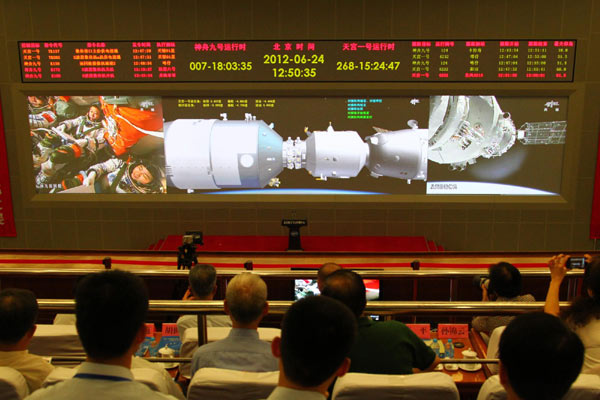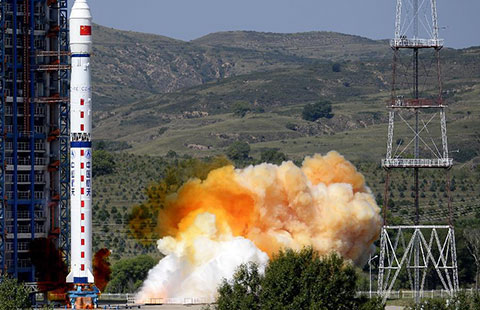

BEIJING - Three Chinese astronauts Sunday successfully completed a manual docking between the Shenzhou IX spacecraft and the orbiting Tiangong-1 lab module, the first such attempt in China's history of space exploration.
It means China has completely grasped space rendezvous and docking technologies and the country is fully capable of transporting humans and cargo to an orbiter in space, which is essential for building a space station in 2020.
Astronaut Liu Wang, assisted by his teammates Jing Haipeng and Liu Yang, controlled the Shenzhou IX spacecraft to dock with the Tiangong-1 space lab module at 12:48 p.m., which were reconnected about seven minutes later.
About one and a half hours before the docking, Shenzhou IX parted from Tiangong-1 to a berth point 400 meters away from the module.
To leave room for adjustments, engineers set up four berth points for the spaceship on the same orbit 5 km, 400 meters, 140 meters and 30 meters away from the orbiting lab.
As highly sophisticated space manoeuvre, manual docking requires the astronaut to connect together two orbiters traveling at 7.8 kilometers a second in space without a hitch.
Shortly after the docking, the smiling and waving astronauts greeted the ground crew via camera.
"The manual docking was beautifully conducted. It was very accurate and swift, " said Liu Weibo, who is responsible for China's astronaut system.
The manual docking was completed in only 7 minutes, 3 minutes faster than the automatic docking, said Liu.
Liu explained to Xinhua the three factors behind today's manual docking success.
Firstly, Liu Wang has grasped the sophisticated manual docking technologies very well and his psychological status has been sound. Secondly, the three astronauts were in close cooperation. Thirdly, the domestically-made docking system was reliable, he said.
The astronauts, 343 km away from Earth, were also greeted by Chinese oceanauts from the Mariana Trench, 7,020 meters beneath the Pacific Ocean, where they just broke the country's dive record in a manned submersible on Sunday morning.
 |
|
A screen at the Beijing Aerospace Control Center shows the manual docking between Shenzhou IX spacecraft and Tiangong-1 lab module being conducted, on June 24, 2012. [Photo/Xinhua] |
"We hope the manual docking is a great success and wish for brilliant achievements in China's manned space and manned deep-sea dive causes," read the message sent by the three oceanauts aboard the manned submersible Jiaolong.
Wu Ping, spokeswoman for China's manned space program, said Sunday the manual space docking was "a complete success."
She told a press conference in Beijing that the three Chinese astronauts had already re-entered the space lab module to continue their scientific experiments.
The spacecraft and the space lab were previously joined together by an automated docking last Monday. The three astronauts, including the country's first female astronaut, Liu Yang, were sent into space onboard Shenzhou IX on June 16 from a launch center in northwest China's Gobi desert.
China succeeded in automated space dockings between the unmanned spaceship Shenzhou-8 and Tiangong-1 late last year.
"The automated docking and manual docking are both essential and they serve as a backup for each other," said Zhou Jianping, designer-in-chief of China's manned space program.
The manual docking is a significant step for China's manned space program that celebrated its 20th anniversary this year, as China has fully grasped space travel, space walk and space rendezvous and docking technologies that are essential to building a space station, Zhou said.
China is the third country, after the United States and Russia, to acquire technologies and skills necessary for space rendezvous and docking and be able to supply manpower and material to an orbiting module via different docking methods.
The Shenzhou IX spacecraft is scheduled to part from the Tiangong-1 module manually in four days and take the three astronauts back to Earth next Friday, which would set a record for the longest space travel in the history of China's manned space program.
Wu Ping said China has planned about 19 billion yuan (3 billion U.S. dollars) in budget for the country's space rendezvous and docking missions
The budget will cover the ongoing Shenzhou IX spacecraft manned space docking mission, the previous missions conducted by the Shenzhou-7 and Shenzhou-8 spaceships, as well as the mission to be carried out by the Shenzhou-10 spaceship next year.
Since starting the manned space missions in 1992, Wu said, the country has spent another 20 billion yuan on manned space missions carried out by Shenzhou-6 and previous spaceships.
Three astronauts who participated in China's first manual space docking mission also congratulated those who partook a new national dive record set by the country's manned submersible in its exploration in the deep ocean.
"We wish China's manned submersible can make greater achievements! May our motherland prosper!" the three Chinese astronauts said in a video message sent back to Earth from the Tiangong-1 space lab module around 5:40 p.m. Sunday.









